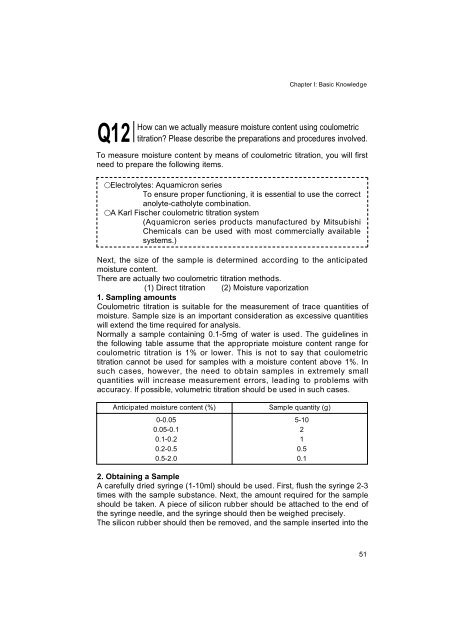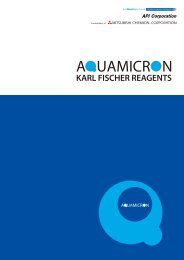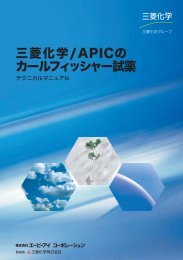Development of Karl Fischer Reagents
Development of Karl Fischer Reagents
Development of Karl Fischer Reagents
Create successful ePaper yourself
Turn your PDF publications into a flip-book with our unique Google optimized e-Paper software.
Q12<br />
Chapter I: Basic Knowledge<br />
How can we actually measure moisture content using coulometric<br />
titration? Please describe the preparations and procedures involved.<br />
To measure moisture content by means <strong>of</strong> coulometric titration, you will first<br />
need to prepare the following items.<br />
�Electrolytes: Aquamicron series<br />
To ensure proper functioning, it is essential to use the correct<br />
anolyte-catholyte combination.<br />
�A <strong>Karl</strong> <strong>Fischer</strong> coulometric titration system<br />
(Aquamicron series products manufactured by Mitsubishi<br />
Chemicals can be used with most commercially available<br />
systems.)<br />
Next, the size <strong>of</strong> the sample is determined according to the anticipated<br />
moisture content.<br />
There are actually two coulometric titration methods.<br />
(1) Direct titration (2) Moisture vaporization<br />
1. Sampling amounts<br />
Coulometric titration is suitable for the measurement <strong>of</strong> trace quantities <strong>of</strong><br />
moisture. Sample size is an important consideration as excessive quantities<br />
will extend the time required for analysis.<br />
Normally a sample containing 0.1-5mg <strong>of</strong> water is used. The guidelines in<br />
the following table assume that the appropriate moisture content range for<br />
coulometric titration is 1% or lower. This is not to say that coulometric<br />
titration cannot be used for samples with a moisture content above 1%. In<br />
such cases, however, the need to obtain samples in extremely small<br />
quantities will increase measurement errors, leading to problems with<br />
accuracy. If possible, volumetric titration should be used in such cases.<br />
Anticipated moisture content (%) Sample quantity (g)<br />
0-0.05<br />
0.05-0.1<br />
0.1-0.2<br />
0.2-0.5<br />
0.5-2.0<br />
5-10<br />
2<br />
1<br />
0.5<br />
0.1<br />
2. Obtaining a Sample<br />
A carefully dried syringe (1-10ml) should be used. First, flush the syringe 2-3<br />
times with the sample substance. Next, the amount required for the sample<br />
should be taken. A piece <strong>of</strong> silicon rubber should be attached to the end <strong>of</strong><br />
the syringe needle, and the syringe should then be weighed precisely.<br />
The silicon rubber should then be removed, and the sample inserted into the<br />
51




